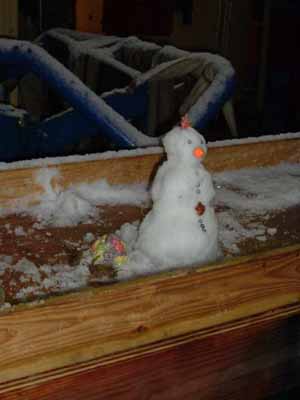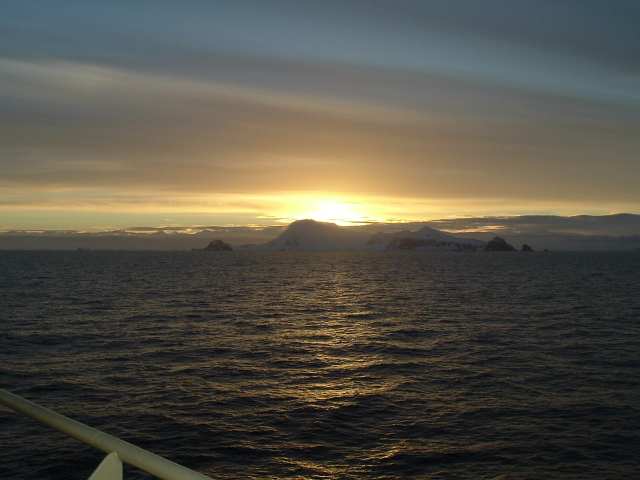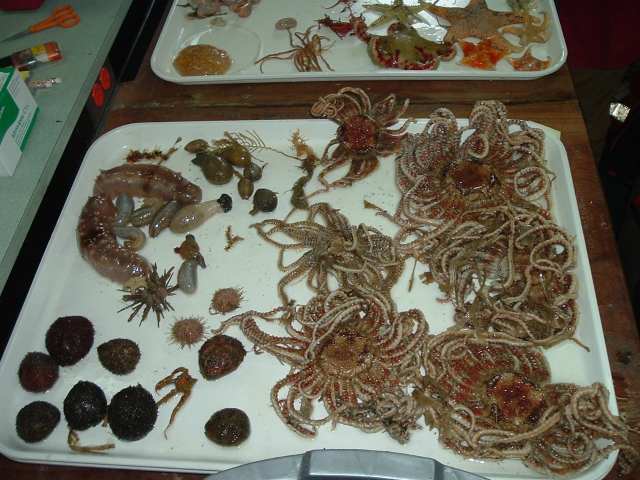[Wind: W 25kn / Air Temp: -0.2C / Wind Chill: -19C /Depth: 934m/ Water Temp: -1.5C]
| • Home |
| • Questions |
| • Participants |
| • Background Information |

| 1 | 2 | 3 | 4 | 5 | 6 | |
| 7 | 8 | 9 | 10 | 11 | 12 | 13 |
| 14 | 15 | 16 | 17 | 18 | 19 | 20 |
| 21 | 22 | 23 | 24 | 25 | 26 | 27 |
| 28 | 29 | 30 |
| 1 | 2 | 3 | 4 | |||
| 5 | 6 | 7 | 8 | 9 | 10 | 11 |
| 12 | 13 | 14 | 15 | 16 | 17 | 18 |
| 19 | 20 | 21 | 22 | 23 | 24 | 25 |
| 26 | 27 | 28 | 29 | 30 | 31 |
Science is like that, and this cruise is a good example of it. You may have a plan, a very tidy schedule all laid out, but weather and other circumstances such as equipment or personnel can change everything. Things don’t go all a-flutter, however, but scientists have to be somewhat patient, and have a “Plan B” at all times. It has been very interesting for me to see how the different teams work together to adapt to changes so that everyone pretty much gets to do what they need to do or collect or see, even on a modified plan. You know what? Life is like that, too.
We did a couple of plankton tows over the day today, but they didn’t yield too much in the way of larvae. Not surprising, I’m told, for the location. But the benthic tows brought up plenty as usual, and were very muddy on this course. It took two watches’ worth of detailing to get one of the trawls done (about 7 hours). Brittle Stars and Sun Stars are no longer ‘exotic’ to me…
Dr. Ken Halanych of Auburn University in Auburn AL is the Chief Scientist of this cruise. The Chief Scientist is the top of the heap as far as the hierarchy of the science crew of the ship goes. He is the main liaison with the Captain, and mostly calls the shots for research stops (we make several a day, out here in the open sea). The general science plan goes through Ken – that is, what the other scientists on board wish to accomplish as participants on the cruise - and he coordinates the trawls and tows and even the ‘recreational stops’ with the Captain. As I said before, this is a kinetic or moveable plan, and Ken keeps the posted Plan Schedules up to date (a new one each day), even when they sometimes change from hour to hour. Can you imagine the responsibility of this job? I wonder how the man gets any sleep or keeps from looking like an unmade bed! Well, the getting sleep part, anyway. We all look like unmade beds! Today Croc, one of the chefs, baked a cake in recognition of Ken’s efforts. (A dubious honor. Yesterday he baked a cake in recognition of a wind shift, and the day before for someone’s 7/12 birthday…)
Ken has his own science agenda to accomplish during this cruise, and his focus is more on the “adult critter” populations we’re encountering here (in contrast to, but in collaboration with Rudi Scheltema’s focus on larvae). Most of what we pull up in the benthic trawls belongs to Ken and his lab at Auburn. I’ve asked him to describe for you what he is looking for in the Antarctic waters:
One of our main missions is to decide whether the strong currents that flow around Antarctica have caused some of the marine animals to be genetically different from the same types of animals in the waters near South America. As you may know, evolution is an ongoing process, and one of the things that causes new species to arise is the physical isolation of different groups from each other. When two groups of animals are separated from each other, then they can’t breed with each other any more; evolution can act slightly differently on the two groups and so, as time goes by, they can become less and less like each other. This is called ‘genetic drift’. As the two separated groups become more and more different, they can even become separate species. Currently, many of the species of organisms we’re seeing are considered endemic to Antarctica, that is, they only live in Antarctica. However, some groups of animals such as annelid (segmented) worms and sea cucumbers contain several species that are reported to occur in other areas as well as in Antarctica. If they do occur in other areas, how do individuals get from one place to the other? (see Journal #8, Rudi Scheltema’s mission)
About 30 million years ago, during the Oligocene epoch (when Antarctica and South America separated), water began flowing all the way around Antarctica (i.e., circum-Antarctic current). Before this time, the Drake Passage (which is the deep water we just crossed) was shallower, and the water didn’t flow all the way around Antarctica like it does today. We think that the stronger currents that exist there now may have isolated a lot of marine populations and created differences between those above the current and those down by Antarctica. To test this theory, we are collecting small animals of similar species from both places (and some in between, to test the swirl and eddy theory of transport) and freezing them. When we get home to our bigger laboratories, we will look at these animals’ DNA (the molecules which make up their genes) to see how significant the differences are between the groups above and below this circum-Antarctic current. [edited text by Grant McCardell, UConn and E. Bailey, LMG]

Photo3

Catch of the Day: We had enough snow overnight to build a snowman on the sorting table. There is no limit to the resourcefulness of our able ship’s crew and science personnel.
Our triangular path today started about 6 miles NE of Livingston Island, then SW and W the length of Liv. I. to Snow I., toward Smith I. Turned back due E to south side of Deception I.
Dinner Menu (shipboard, 12/7): |
|
TBD |